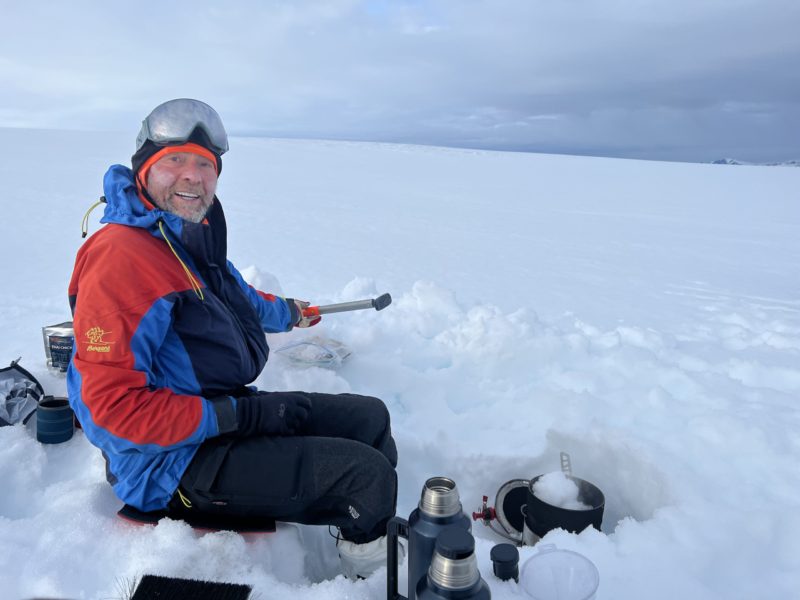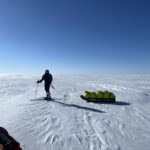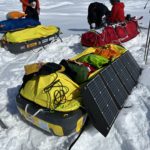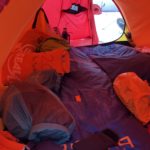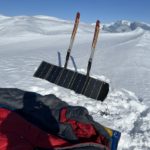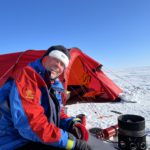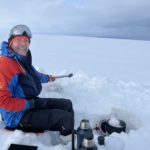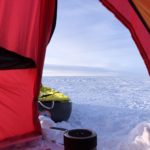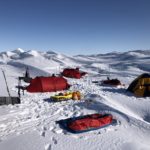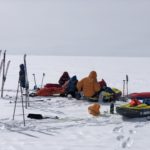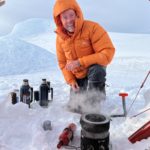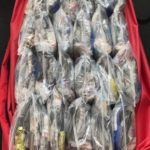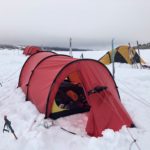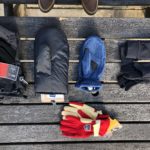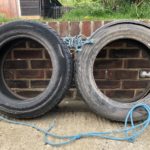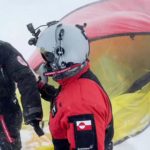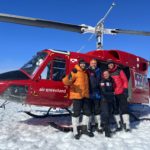We learned a lot crossing the Greenland icecap in May 2022. Skiing 565 km to close 552 km between Point 660 on the west coast near Kangerlussuaq and the Grill Hut on the east coast near Isortoq exposed us to its brutality and stunning beauty in equal measure. We experienced all weathers and temperatures from the initial crevasse field, over the top at 2,500m above sea level and down the other side into June. Blue ice, snow, blizzards, howling 80kph winds, icy conditions, melting snow, flowing water, and temperatures from 0C to -24C with wind chill down to -37C. We averaged 19.4 km per day over the 29 days and 4 hours it took us in total. We averaged 22.8 km per day while able to ski for 24 days and two hours. We sadly lost our leader, Mikael Strandberg due to a severe concussion when he was evacuated on the morning of Day 02. The icecap tested our preparation, equipment, and resolve.
We had of course established all the necessary SAR procedures and filed all the necessary application paperwork. When it came down to it our medical emergency evacuation for Strandberg happened professionally and quickly: the mission doctor made his recommendation by Iridium sat phone, the helicopter arrived at our Garmin inReach co-ordinates rapidly, and the insurance company, Kalaallit Forsikring sorted payments almost immediately. Our expedition permit was reassessed for continuation within two hours.
Personally, I was as prepared for this expedition as one can be. Fitness-wise pulling tyres for over 500km was sufficient preparation for pulling the sled through all sorts of conditions and the Nylas sled was perfect except for the downhill elements on the last day when the sled was harder to manage (we were using ropes). Living in the environment-wise talking to Strandberg, reading Dixie Dansercoer’s book, Polar Exploration and getting equipment advice from Rhodri Lewis of Nordic Life on equipment was my starting point.
However, ‘if’ I was to repeat the expedition, I would change my strategies for head and face clothing, my tent, food, and stove to provide better protection and better time efficiency to keep out of the weather while not under way. Here’s what I would repeat and what I would do differently. I hope you find it helpful.
Clothing: I needed more and better headgear and glove options to deal with wet, wind and perishingly cold conditions including vapour barrier gloves stronger than latex. While camping, decamping, and placing snow chunks to boil water I used base layer gloves and leather, fingered gloves which got wet fast which got wet fast, and I resorted to a latex vapour barrier between: sweating dampened my base layer gloves, but my hands stayed warm. Obviously wiping my backside with my dominant hand while going to the toilet outside exposed that hand further to the conditions (see tent ideas below). For my ‘layer four’ Bergans Artic Expedition jacket I would substitute a modern, smooth zip-eliminating Velcro jacket and carry a spare in case of zip malfunction because Velcro is annoyingly time consuming and encourages glove removal (bad) to get right. I’d probably do that with the salopettes too although the robust nature of my Brynje Expedition salopettes with their raspy knee material that could be used to wipe snow and ice, gloves, etc., was a great feature.
Tent: I would be one person in a two-man tent which handles wind shifts better than the tunnel tent we used – something from North Face rather than Hilleberg. If using a tunnel tent, then I would choose the Hilleberg Keron 3GT with its extra section over their Keron 3. Finally, I would tape the tent poles so that the tent was part-assembled and store it rolled in a longer tube for quick ‘put up’ and ‘take town’ – Milka did this and she was easily the fastest with her tent. We used skis, our poles with screw-off baskets, snow pegs and sometimes ice screws to hold the tent down. I would go for speed with dedicated pegs. The tent must be big enough to do everything inside once it’s up including cooking and going to the toilet #1 and #2 to be out of the weather when not travelling – especially in very cold conditions and bad weather. I would also put the sled contents into a few big waterproof bags to speed of transfer of everything to and from the tent. Fussing around these bags in the comfort of the tent I would be out of the elements – Mikael did this and he was easily the fastest to appear from his tent and then be harness and ready to go. Dry bags are crucial to keep everything dry in the tent where condensation is always a problem. However, a bigger tent with one occupant reduces the levels of condensation even when cooking inside. We were two in a two-man tent making 12L of water per day. Mattsson’s North Face tent had a vent at the top that he could easily open from the inside. Details matter.
Food: I would go for much more variety in the dehydrated food and carry about 4,000 kcal per day of that with 1,500 kcal (the rest) coming from snacks and comfort food for easy use during the day including ‘drink meal substitutes’, chocolate, bars, hydration tablets, etc. Eating or snacking in a blizzard or very high, cold wind is very difficult to do. Just pouring hot water from a flask to a ‘drink meal substitute’, stirring it and drinking it exposes your hands and mouth. So, preparation in the tent of a flask to drink food from or a Nalgene bottle to ‘drink’ a nuts and chocolate mix from is key.
Flasks: I would add one more 1.9L Stanley to my 1 x 1.9L Stanley + 2 x two x 375ml flasks for hot water to extend the time between having to boil water if necessary. The big, full Stanleys hold their temperature well for 24 hours in these conditions. The 375ml flasks are good for 12 hours, keep your boots from absolutely freezing at night when inserted and one of them is enough to charge the pot for water making.
Stove: I would carry one per person even if I was sharing a three-man tent with another (for the space) and make my own water (see the fuel story later), use a heat exchanger on the pot and carry all my fuel in leak-proof MSR bottles which only require changing over and avoid any refilling. I didn’t have to clean the stove at all through the whole 32 days of use making over 360L of water and burning for over 45 hours which is a testimony to the durability of the MSR EGK stove. It preformed magnificently lighting up with Storm matches – you don’t need anything else.
Fuel: James Ketchell and I took 0.33L of fuel per person day for 30 days (so, 10L each, making 20L total) for producing up to 6L of water per person. The JET fuel burn experiments in the UK had shown we only needed 0.29L. In the real world of Greenland, we used 13L of fuel over 30 days producing and average of 12L of water per day so, we used about 0.22L fuel each per day. In hindsight we need only have carried 6.6L of fuel each. I’m not sure why our testing indicated we needed quite so much more but it was better to err on the side of enough! Also, there are lots of variables including ambient temperatures from -23C to -5C, snow temperatures, how much of our flasks we did have left to increase the quantity of priming water. So, although we made about 12L every day we didn’t make it all from frozen snow. If I were going again, I would work with about 0.25L per person day to produce 6L of water. However, I think the performance of the stove could be enhanced with a heat exchanger around the pot compared with the shield we used.
The fuel story is more interesting than that because of the different consumption of water between us: James needed up to about 8L daily and more often consumed all his water; I used no more than 4L daily and always kept one 375ml flask to prime the water-making and often had some more left in my 1.9L flask to add to that. People are different. Interestingly Mikael Mattsson (mass about 100kg) also operated on about 4L daily and Milka Raulin (mass about 52kg) on about 3.7L daily. So, based on this experience I needed 5L of fuel to produce my 4L per day for 30 days. James needed 9L of fuel to produce his 8L of water per day for 30 days. Wow.
Tent brush: I needed two types; one for light snow which I used all the time to keep my Hestra working gloves clean while boiling water, clean out the tent, brush shoes, etc., and something like a harder nail brush for the removal of matted, more stubborn snow and ice from Velcro areas on boots and clothing.
Tools: For mission critical, single point of failure items we needed good leather sewing equipment to repair the Alpha boots and some metal plates, self-tapping screws, and washers to repair the boot spindle connection to the bindings and spare bindings. We didn’t have that but another team we talked to in Kulusuk had to fix exactly these problems after only 26 days on the ice. We did carry the tools to remount spare bindings. James broke two bindings and all our boots suffered ‘work hardening’ wear about the big toe knuckle area as a combined result of skiing working the leather and then freezing water expanding the leather diurnally. This is not a great advert for using Alpha boots on longer polar trips.
Comfortable sitting: I tell you what worked well was a neoprene pad for kneeling and sitting on when boiling water, entering the tent, or resting your feet on while changing socks. Next time I would make it bigger and thicker for extra insulation. I would certainly consider the range of seat from Thermarest.
Sled: I was extremely happy with my choice of Nylas sled. It was 210L and very easy to pull because of its two runners and ship bow front shape. It was easy to man handle in the crevasse field with its six rope handles and using ropes each end. The metal harness of the Jemtlander sled was better downhill because it couldn’t run into the back of you. But the Nylas sled was easy to toboggan and steer by leaning down steeper gradients – James and I covered about four kilometres this way. So, for 28 out of the 29 days the Nylas was best.
Harness: I was very happy with my choice of standard Fjellpulken harness arrangement. Pulling tyres had prepared my body for all the tugging and taught me how to lean into it to reduce that. I did away with the shoulder and leg harness elements and cut the plastic connectors away so that there was nothing to interfere with a climbing harness which we might also wear. I wore it low on my waist and about an inch below the top of my hip bone. It worked perfectly for 500 km of tyre-pulling and 565 km of sled pulling.
Sleeping solution: After our tent our sleeping bags kept us cosy and warm, and we looked forward to getting a good night’s sleep every day. In fact, above about -10C they were too hot. We had two Hellsport bags one inside the other on top of a Thermarest Ridgerest, on top of a Thermarest Air all sipped up inside a Piteraq Arctic bedding bag. With the Thermarest Air partly deflated we could manhandle the bag from the sled into the tent and back easily. On the sled we could either run with the bag on top and partially unzipped to dry and air the sleeping bags or within the sipped bag with the solar panel on top. At lunch or when making camp on a sunny day we could chuck on the ground and unzip for drying. It was great. Milka, James and I had the same arrangement.
Power & communications: TotalCool provided us with 3 x 100-watt solar panels (weighing only 3.1kg when stripped) and 3 x 144 watt-hour power banks (weighing only 0.85kg) to meet our exacting requirements for communications, navigation, beacons, cameras and drone. Even on a sunny day our panel would only provide 40% of their potential capacity at this high latitude but we were pleased with this capability. On a sunny day we laid the panel out on the sleds and in about eight hours our power banks were full. At the end of a sunny day, we propped the panels up with our skis as while we made camp and charged our Garmin inReach devices. We couldn’t have asked for better performance nor value and it was so easy to erect the panels and fold then back at snack and drink stops. Iridium sponsored our communications providing sat phones and Sim cards for our use and kindly setting them up for tracking our progress across the ice cap. It was so easy for us all to make any necessary calls to family, authorities, SAR and in James’ case his schools obligations answering kids’ questions and the voice pop nightly update to his tracker (very clever service from zerosixzero). The 28 watt-hour batteries seemed to last forever. I wouldn’t do anything like this without an Iridium sat phone.
Hygiene: I took single packaged Dude wipes for personal hygiene. I just popped a couple of wipes, my eye drops, and small tooth paste tube in a pocket close to my body for a few minutes and everything was useable. just pop in pocket to defrost. How many toilet rolls is a common question? I took six and used 5.5 but did suffer with the food not agreeing with me from about day six onwards. I ran out of Imodium on Day 27 and made a lot of ‘bathroom stops’ on our last 45km-day effort when their effect wore off!
If you did have specific equipment questions, I would be happy to answer them. What’s next?
2384 words
Peter Wilson
Adventurer, Pilot, author
Three Journeys Round, Facebook
Two Rotors: One Planet, Earth and Low Level
Geographical Magazine’s review of Earth
